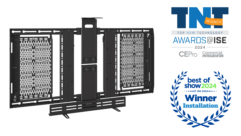

Telemedicine: Life, Death and AV?
AV professionals can’t often say that their work involves life-or-death issues, but in the growing health care niche known as telemedicine, they can. In fact, ensuring high-quality, reliable video signals is a non-negotiable objective of every telemedicine project.
AV professionals can’t often say that their work involves life-or-death issues, but in the growing health care niche known as telemedicine, they can. In fact, ensuring high-quality, reliable video signals is a non-negotiable objective of every telemedicine project.
Broadly defined as the use of telecommunications to deliver medical information and services, the sort of telemedicine that concerns AV integration almost always involves distance conferencing. Other segments of this broad field, such as home monitoring, electronic health records, and subspecialties like teleradiology, don’t directly touch AV technology. But even that’s changing, as telemedicine users ask to integrate conferencing with all other electronic information normally at their disposal.
As the most visible form of telemedicine, videoconferencing usually manifests in one of three typical scenarios. The hallmark configuration involves a doctor viewing, diagnosing, and recommending treatment to a patient he doesn’t see in person, but instead interacts with over live video. Another common application allows a doctor or nurse to bring in a specialist for a remote consultation, sometimes during a live procedure, such as open-heart surgery or triage on a trauma patient.
In a third common scenario, patient exams and certain medical procedures are transmitted to distance-learning facilities at hospitals and universities, providing students with real-world, practical instruction–even the chance to question the surgeon. Or, students can join “grand rounds,” a long-standing practice in teaching hospitals, in which medical students visit a series of patients in their rooms. But thanks to videoconferencing, they never leave the auditorium.
This last scenario was what the University of Arizona had in mind when it upgraded AV systems and conferencing equipment in an amphitheater at its Institute for Advanced Telemedicine and Telehealth, or T-Health Institute. The institute is basically a teleconferencing hub that allows students, professors, and working professionals to participate in live meetings from various locations. Plus it lets them switch among discussion groups almost instantly, says Jim Mauger, director of engineering at integrator Audio Video Resources, which worked on the project.
The institute standardized on Tandberg videconferencing systems, including six in the amphitheater alone, Mauger says. Virtual meetings take place in the amphitheater, which sports a videowall comprising 12 50-inch Toshiba P503DL DLP Datawall RPU video cubes controlled by a Jupiter Fusion 960 processor. Digital signal processors control audio from 17 student desks, each equipped with a microphone and headphones. Visitors to a rear gallery can don headphones and listen in on the conferences while they watch through a window.
An instructor uses a Crestron control system to choose how up to 16 conference participants are grouped on the wall, with Extron hardware switching the feeds.
In fact, controlling the participants’ audio and video feeds so they could be quickly grouped and regrouped according to instructional needs was the biggest challenge. Attendees can participate in a single large meeting, or they can be broken into groups. One group of screens might be outlined in blue and the other in red to distinguish between the two meetings. “We developed a pretty elaborate request-to-speak queuing system,” Mauger says, including a Crestron HTML page that displays the names in the queue.
When the Doctor Is In–Or Out
Of course, telemedicine as education and telemedicine as actual health care can be two different things. By some estimates, only 10 percent of operating rooms are currently outfitted for telemedicine, representing a significant business opportunity, provided AV professionals do their homework.
“AV integrators need to understand the workflow of the operating room,” says Ron Emerson, Polycom’s director of global health care markets.
Which is to say nothing about the physical dynamics of actual operating rooms. For example, where video isn’t as high a priority, audio conferencing, integrated correctly, can be an important enabler of telemedicine.
“There are some real challenges in an operating room from an audio standpoint,” says Scott Woolley, director of product marketing at ClearOne, a maker of audio digital signal processors (www.clearone.com). “The walls are tiled. There’s no acoustical absorption in them at all. You have to be careful that the microphone placement is done well. There’s other equipment that’s fairly noisy.”
Line and microphone level inputs and noise cancellation in DSPs like ClearOne’s ConvergePro 880TA help ensure each participant’s voice is intelligible above the din of an OR.
Experts says health care facilities lag other industries in adopting AV and information technologies. “For example, they’re just now getting into HD,” says Paul White president and founder of Beaverton, Ore.-based CompView Medical, a market-specific spinoff of AV integrator CompView (www.compviewmedical.com). But now that hospitals are incorporating high-definition imagery, they’re moving quickly to establish the video infrastructure to meet their needs. HD’s high-resolution images have begun driving telemedicine investment because of its ability to show very fine detail and color–key for visualizing those hard-to-reach places in the human body.
The challenge comes in getting those HD signals where they need to be. Woolley says some hospitals ensure the quality of OR video by piping the signal uncompressed, without running it through codecs (though they still use codecs for conferencing away from the OR). Coax or fiber-optic cabling are typical, though as in other markets, more hospitals are considering transmission over Cat-5 cables to save money and retrofit existing rooms.
Still, not all telemedicine applications need high-definition video. “You may have a high-definition camera but the platform that you’re using is not high-definition,” says Neal Schoenbach, telemedicine design manager for GlobalMedia (www.globalmedia.com), a solution provider in Scottsdale, Ariz.
“More than resolution, we really focus on how much bandwidth is being used,” says Polycom’s Emerson, a registered nurse and former American Telemedicine Association (ATA) board member. According to Emerson, the typical bandwidth for clinical applications is only 384Kbps.
In any case, video signal distribution is playing a greater role in hospitals, in part because many want fewer codecs to serve more rooms. Rivulet Communications, a Herndon, Va.-based vendor that tailors solutions to telemedicine, utilizes video over IP (www.rivulet.com). Its Dynamic Synchronization Technology carries video over the Cat-5 already running a hospital’s data network, and without the extra boxes to convert from analog. Rivulet ensures quality-of-service (QoS), in part by piggybacking on the QoS features in Cisco routers. Another product, its IP Expansion Gateway, extends the benefits outside the hospital. “It will allow someone at home on a low-bandwidth connection to log in securely and watch video of an operation,” says Jeff Schmitz, Rivulet’s senior vice president of sales and marketing.
Telemedicine: Life, Death and AV?
AV professionals can’t often say that their work involves life-or-death issues, but in the growing health care niche known as telemedicine, they can. In fact, ensuring high-quality, reliable video signals is a non-negotiable objective of every telemedicine project.
The company has also tackled unique telemedicine challenges, such as integrating other medical data into a conference, including time-synchronizing stored video with patient data, says Schmitz. Such an integration means adhering to security measures unique to health care (see: What Makes Health Care AV So Different?).
New York University used Rivulet products to save $48,000 a year on custom cabling to transmit video from ORs during special events, according to Rivulet. Similarly, HaiVision Systems has placed video-over-IP equipment in several high-profile telesurgery applications, including at Titan Medical in Canada, where its hai1000 network video system and Mako-HD H.264 codec were used to test Titan Medical’s Amadeus robotic surgical system over Bell Canada’s IP-VPN network (www.haivision.com).
Getting Market-Specific
The fact is, while conferencing systems and signal distribution technologies aren’t unique to health care and telemedicine, there are AV solutions and providers tailored to the market. Two vendors in the health care industry, Kalamazoo, Mich.-based Stryker (www.stryker.com) and Karl Storz Endoscopy-America in El Segundo, Calif., share much of the market in OR telemedicine systems, often doing their own integration. Karl Storz recently signed an agreement with Rivulet to resell the latter’s HD video solutions.
CompView Medical, for its part, makes an AV equipment-management system, called NuBOOM, for upgrading ORs to telemedicine. NuBOOM has two 9-foot booms for positioning displays and holding cables and equipment, both AV and medical. Another product, DOCS, is an FDA-approved touch screen for viewing, controlling, and routing medical images.
Then there is the humble AV cart, an integrated AV system not particularly foreign to hospitals, which often transport other medical systems on such mobile carts. The cart is arguably the locus of telemedicine, a single platform for audio and video inputs and outputs sitting alongside medical instruments and ideally integrated for conferencing.
Because they’re mobile, carts can make telemedicine more affordable by reducing the need for AV upgrades in every room. Carts also help with cable management by providing retractable bays, and their medical instruments sometimes work better than their traditional counterparts (one obvious example is a stethoscope, which can be amplified). While both Polycom and Tandberg sell videoconferencing carts for the health care market, a number of medical-equipment vendors do too, sourcing the conferencing components from well-known AV manufacturers.
While most carts are self-supporting on roller stands, GlobalMedia makes a new alternative, called the TransportAV, that attaches to a gurney. It comes with a pan-tilt-zoom camera and “soft” codec for conferencing, an echo-cancelling microphone, headset, military-grade laptop PC, and 3G air card for wireless communication, says Schoenbach. The system also comes with two other GlobalMedia devices: the TotalExam S-Video Examination Camera, which is the size of a small flashlight and meant to capture close-ups, and the ClearSteth electronic stethoscope.
What Makes Health Care AV So Different?
Credit: Peter Krogh
Health care places unique demands on AV. For example, some systems that go into operating rooms require approval from the U.S. Food and Drug Administration (FDA). Moreover, Underwriters Laboratories (UL), the Canadian Standards Authority, and the European Economic Community must certify the electrical safety of AV equipment because of its potential to come into contact with patients or to ignite gases.
The American Telemedicine Association (ATA) issues various guidelines, but they mostly address clinical and administrative procedures, rather than technology. Still, as AV evolves and permeates health care, typical scenarios give rise to a general blueprint for the particular AV design. For example, the ATA makes screen resolution recommendations for certain medical specialties, says chief executive officer Jonathan Linkous.
And the ATA’s guidance continues to evolve. According to Linkous, pro AV has an important role to play in the development of telemedicine, especially in larger hospitals. As a result, it will fundamentally affect facilities and how they’re put together.
“The people involved in telemedicine need to pay more attention to design and environmental factors, such as the lighting in rooms,” says Linkous, who has a broadcast background. But hospitals have only recently had to consider such factors as they relate to integrated systems, so the role of AV consultants and designers will be important.
At the heart of any 21st century health care system are privacy and security, two no-compromise requirements under the 1996 Health Insurance Portability and Accountability Act (HIPAA), which spells out how health care providers must protect patient privacy in everything they do. Granted, much of the security falls to the IT department, which must safeguard data, and to actual caregivers, who need to follow strict procedures. But AV designers and integrators should always keep HIPPA in mind when building a telemedicine system. For instance, operating room displays might need to be angled a certain way so that hallway passersby can’t identify patients or their records, and credentialing requirements might require physicians to hold up ID badges to a camera to prove they are licensed to practice where the patient resides.
Indeed, health care AV, and telemedicine in particular, are very visual applications. Doctors can’t fix what they can’t see. And increasingly, they now consult each other face-to-face–regardless of location.
The Road (and Road Blocks) Ahead
Those who serve the industry say health care customers are among the most high-maintenance an AV professional will ever encounter. Hospitals tend to be run by demanding people who work in stressful, high-stakes situations that are tightly proscribed by government policies and long-standing medical practices. This creates inertia that makes it challenging to introduce new technology that disrupts familiar workflows. Turnover is high, so the doctor who champions your project today could leave for another hospital tomorrow.
Yet telemedicine is revolutionizing health care by blunting the effects of time and distance, bringing medical know-how to more patients. Jonathan Linkous, CEO of the ATA, has an even more ambitious vision. He sees telemedicine becoming more seamlessly integrated with consumer information systems, as well as personal monitoring and drug-dispensing devices, in order to create an intelligent feedback loop between patients and medical expertise.
“What we’re moving toward is something that will eventually allow us to read our own bodies,” he says. “The computer itself will do a diagnosis and provide help. You could actually have implantable devices that could download the data on a daily basis.”
Paul White of CompView Medical says better integration of AV and IT can bring huge efficiencies to hospitals, many of which have clinical data and medical-imaging systems that can’t talk to each other, resulting in an excess of dedicated PCs and workstations. Even the caregivers’ habits for repositioning surgical tables for particular procedures can frustrate AV consultants who are used to smoothing workflow inefficiencies.
“We just see so much waste every day,” White says. “It’s sad.” Linkous echoes the point, calling health care’s political and administrative status quo the biggest barrier to adopting new technology.
Though he recognizes the special opportunity AV has to improve lives, White cautions other integrators about the challenges of serving the health care/telemedicine market. “I had no idea it would take this long and cost this much money,” he says of his experience moving from general AV to health care. “It’s not for the faint of heart. It is a lot more time- and labor-intensive than you ever imagined.”
Mauger says security fears often get in the way, and that he must sometimes convince customers it is safe to run conferences encrypted on the public Internet, rather than the dial-up lines they are more familiar with. In fact, some institutions have rules requiring the older connection methods.
Mauger says frequent and intensive interaction with health care end users is more important in this market than in other. “There’s a lot more close interaction that needs to happen for a successful project.”
David Essex is a freelance technology writer based in Peterborough, N.H.










